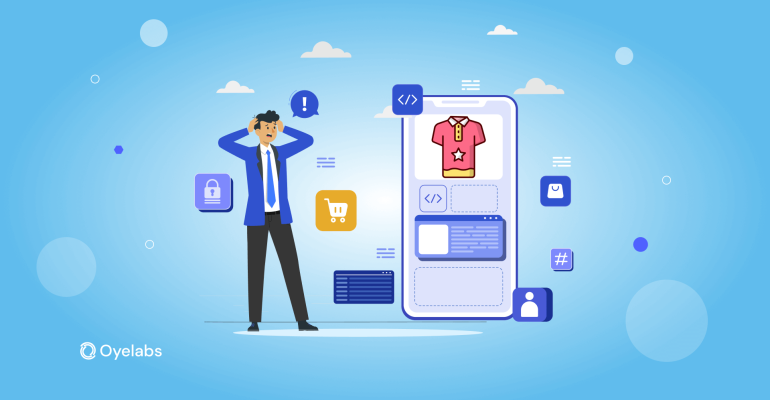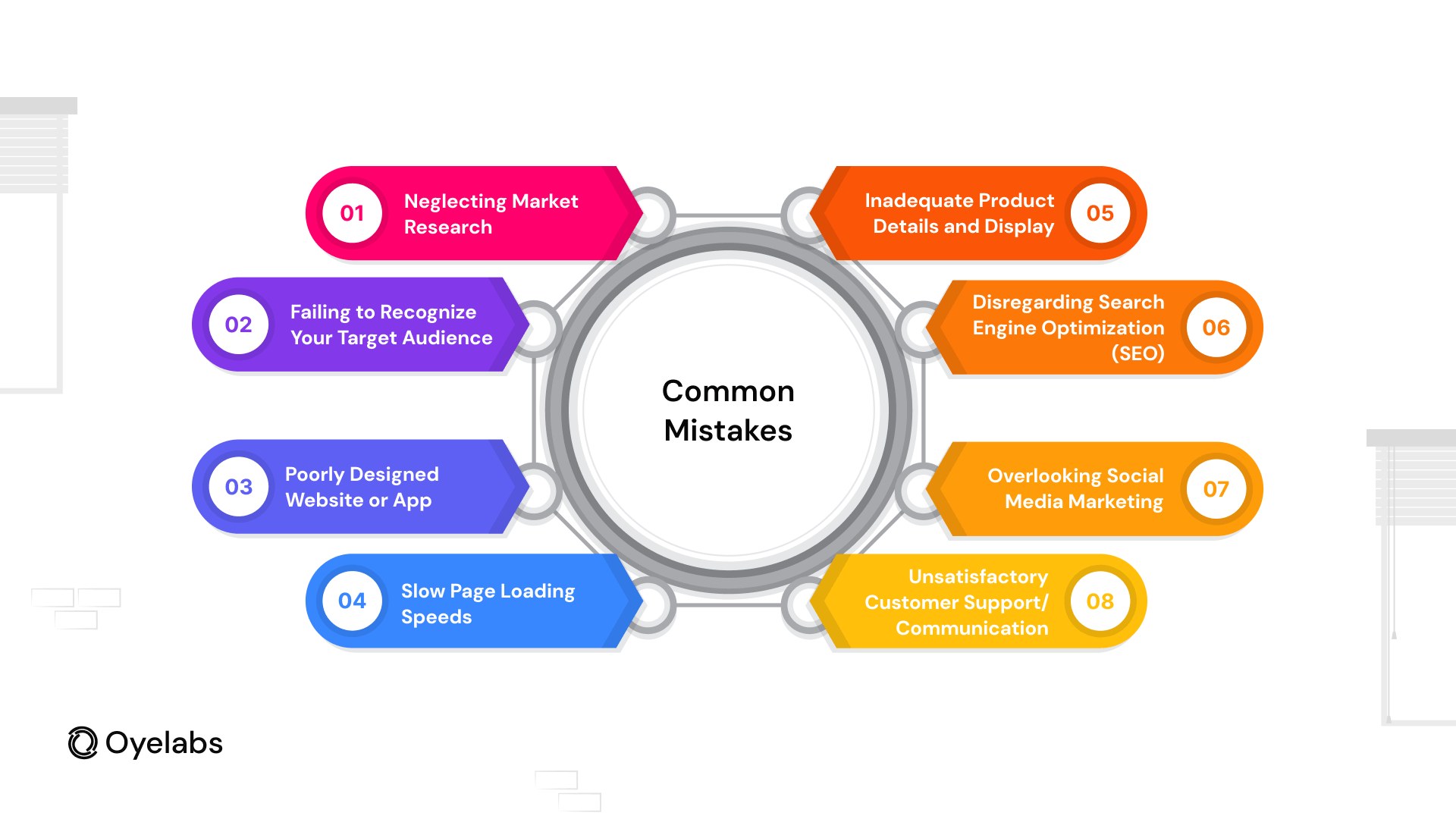Key Mistakes to Avoid in eCommerce App Development – Startups

Key Mistakes to Avoid in eCommerce App Development – Startups
Last Updated on October 20, 2024
Developing a successful eCommerce mobile app is not as easy as it appears. Ecommerce app development involves more than just impressive designs and expert coding. A single mistake might result in lost sales and harm your reputation in a fiercely competitive market, especially with platforms like Amazon setting high standards. Over 80% of eCommerce businesses fail within their first year, and 30% of small and medium-sized enterprises (SMEs) close down just as quickly, highlighting the substantial risks and limited margin for error.
However, don’t let these numbers discourage you. eCommerce stores have the potential to be incredibly lucrative, offering substantial rewards in revenue, brand recognition, and customer loyalty. Success is within reach; it just requires a strategic approach.
When starting ecommerce app development, the initial step should be to steer clear of the typical mistakes that numerous startups encounter. With careful planning, smart execution, and ongoing improvements, your application can thrive, boosting user engagement and enhancing your sales performance. In this blog post, we’ll uncover the most common mistakes made during ecommerce app development and share practical tips to help you steer clear of them.
8 Key Mistakes eCommerce Startups Must Avoid
1. Neglecting Market Research
One of the most significant mistakes eCommerce startups make is neglecting market research. Market research is essential because it helps businesses understand their target audience, competition, and market demand. Many startups make the erroneous assumption that everyone will want their product, which can lead to disaster.
For example, let’s say you’ve created a line of organic skincare products. Without conducting in-depth market research, you might presume there’s a massive demand for your offerings. But after launching, you may find that the market is saturated with similar products, making it difficult to stand out or capture any significant market share. This can result in overproduction and dead inventory, leading to financial losses.
Solution: Proper market research can prevent these complications. Use surveys, focus groups, and market data to understand the competitive landscape and discover potential opportunities. This will steer the creation of products and marketing tactics to guarantee a successful store launch.
Also Read: Key differences in eCommerce app development for startups vs enterprises
2. Failing to Recognize Your Target Audience
A failure to identify your target audience is another critical misstep. Some entrepreneurs believe their product will appeal to everyone, but effective marketing requires knowing exactly who your ideal customer is. Without this clarity, you’re more likely to waste time and resources on marketing campaigns aimed at the wrong audience.
For instance, if you sell high-end fashion items, targeting older adults or students may result in poor conversion rates because these groups might not prioritize or afford luxury products. Failing to identify your audience also makes it harder to craft personalized shopping experiences, which are crucial in today’s highly competitive market.
Solution: Begin by creating buyer personas—fictional representations of your ideal customers. Identify their needs, preferences, demographics, and buying behaviors. This allows you to tailor your marketing and product offerings to those most likely to convert into paying customers.
3. Poorly Designed Website or App
An attractive and user-friendly website or app is a must-have for customer retention. Poor design is a major reason users abandon online stores without purchasing. Websites cluttered with excessive graphics, confusing navigation, or inconsistent aesthetics drive visitors away, increasing your bounce rate and reducing your conversion rate.
Users should be able to navigate the website intuitively, easily finding what they need. A lack of intuitive navigation and clear product categories can make the shopping experience frustrating, causing potential buyers to leave your store for a competitor’s.
Solution: Prioritize simplicity and user-friendliness in your website’s design. Ensure a neat design, effortless navigation menus, and flawless user experience. Simplify user engagement with your store by implementing clear product categories, a search function, and an optimized mobile experience.
4. Slow Page Loading Speeds
In the fast-paced world of digital commerce, fast load times are crucial. Websites that load slowly often see higher cart abandonment rates. Research indicates that even a one-second delay in loading can cut conversions by 7%. Not only does this irritate users, but it also harms your site’s visibility on search engines.
Large image files, excessive plug-ins, and inefficient code are factors that contribute to slow loading times. Moreover, poor hosting services can impact the speed of your website.
Solution: Enhance your page load speed by reducing image file sizes, limiting plug-ins, and streamlining code. Utilize tools such as Google PageSpeed Insights, Pingdom, and GTmetrix to track and enhance loading speeds. Moreover, consider investing in high-performance hosting services to ensure the best possible speeds.
5. Inadequate Product Details and Display
One of the most crucial aspects of online shopping is product information. In a physical store, customers can touch and inspect products before buying. In eCommerce, shoppers rely entirely on the information and images you provide. If product descriptions are unclear or visuals are low-quality, customers may hesitate to make a purchase.
Additionally, incomplete or vague product details can lead to returns, refunds, and bad reviews. Detailed product descriptions, high-quality images, videos, and customer reviews help build trust and offer a more transparent shopping experience.
Solution: Provide accurate, detailed product descriptions along with high-quality images from multiple angles. Adding videos or 360-degree views can also improve the customer’s experience. Remember, the more information you provide, the more confident shoppers will feel about making a purchase.
6. Disregarding Search Engine Optimization (SEO)
Enhancing your website for search engines is essential for attracting organic traffic. Failing to optimize your pages for search engines might cause potential customers to overlook your store. Startups frequently neglect SEO, prioritizing immediate marketing tactics such as paid advertising. However, relying solely on paid advertising can quickly become expensive.
On the other hand, SEO allows your website to appear organically in search engine results, providing continuous traffic without incurring ongoing advertising expenses.
Solution: Enhance your website using a combination of on-page and off-page SEO strategies. Utilize keyword research tools to discover pertinent search phrases, enhance your website’s loading speed, and produce top-notch content that attracts your target audience.
Moreover, creating backlinks and sustaining an active social media presence can enhance your SEO strategies.
7. Overlooking Social Media Marketing
In an era where social media dominates, neglecting platforms like Instagram, Facebook, and Twitter can severely limit your brand’s exposure. Social media is a powerful tool for engaging with potential customers, showcasing products, and building brand awareness.
Without a social media strategy, you miss out on user-generated content, reviews, and word-of-mouth marketing, which are essential to your overall strategy. Create engaging content, interact with followers, and encourage user participation to build credibility in the eCommerce space.
Solution: Prioritize social media marketing as user-generated content such as product reviews or photos. Use platforms like Instagram and Pinterest, which are highly visual, to display your products and generate buzz around new launches.
Related read: How AI and ML Are Transforming E-commerce Apps?
8. Unsatisfactory Customer Support/Communication
Delivering exceptional customer service is crucial for keeping customers and building brand loyalty. Unfortunately, many startups underestimate the value of effective customer support. Delayed responses or unclear communication can frustrate customers, causing them to turn to competitors.
Furthermore, lacking a 24/7 support system can leave customers feeling overlooked, especially when issues arise beyond regular business hours.
Solution: Deploy AI-driven chatbots to offer 24/7 customer support. These bots are capable of managing standard inquiries, enabling your support team to concentrate on more intricate issues. Ensure that you provide various communication options, including email, live chat, and social media, while also training your team to deliver quick and personalized responses.
Why Choose Oyelabs for eCommerce App Development Services?
Oyelabs is recognized for its expertise in eCommerce app development services. High-quality, tailored solutions are delivered by a seasoned team, whether for custom eCommerce platforms or clones of successful platforms like Alibaba or Amazon. User engagement is enhanced, and sales performance is boosted through innovative features. Cost-effective and punctual delivery is ensured, with transparency and confidentiality maintained throughout the process.
Conclusion
The success of an eCommerce business hinges on thorough planning and effective execution. Avoiding common pitfalls, like insufficient market research and subpar site optimization, is crucial. By utilizing eCommerce app development services from Oyelabs, both user engagement and sales performance can be significantly improved, paving the way for sustainable growth and success for your online store.




